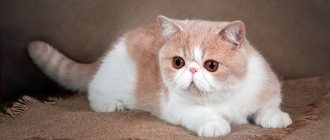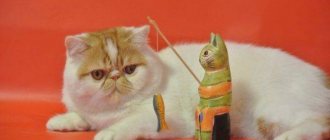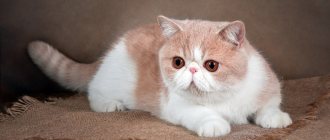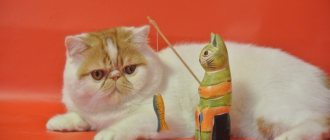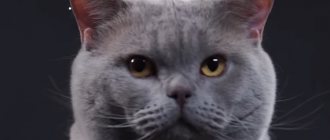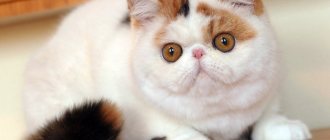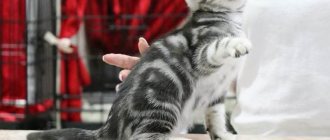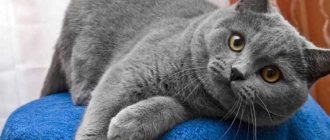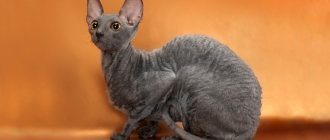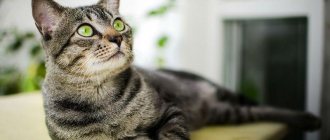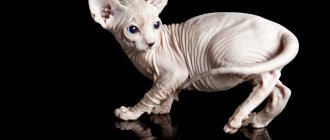- Posted by Yana Gavrikova
- Date: May 15, 2018
An exotic cat is an almost complete copy of a Persian cat. The differences are a very flattened nose and short hair. This breed was bred from the Persians, and it inherited some of their features.
- 2 External features
2.1 Photo gallery: exotic cat
- 6.1 How to organize a toilet for a cat
- 7.1 Castration and sterilization of the breed
History of the Exotic Shorthair cat breed
Exotic Shorthair cat
The appearance of the Exotic Shorthair breed dates back to the 50s of the last century. Frankly speaking, the first kittens appeared completely by accident. Wanting to get new coat colors and eye colors, American Shorthair breeders crossed their pets with Persian cats. Another goal of these attempts was to make the physique of “American women” more dense. The task was not solved. The offspring, to the surprise and disappointment of the breeders, turned out to be very “Persian” - all the animals were born with characteristic “doll” faces. And in other respects, the kids were more like their parents “from the East.” Only the fur became noticeably shorter and acquired a denser, plush structure. As a result of crossing, it was not possible to improve the American Shorthair cat breed, but completely new kittens with an outlandish appearance were born.
Already in 1966, Jane Martink introduced a new breed, which was given the name “Exotic Shorthair”. The accidentally bred cats took a long time to achieve recognition. Ambitious people were critical of “exotics”, believing that they encroached on the purity of this breed. It got to the point that they refused to mate their elite pets with exotic shorthairs, and they did this consciously and in an organized manner. Fortunately, there were far-sighted owners of the “Persians” who saw the prospects and took part in the selection. Among them, special mention should be made of Doris Walkinstick and Caroline Bussey, whose merits in the formation of a new breed can hardly be overestimated.
Representatives of the Russian Blue breed and Burmese cats were also used in breeding work. The experiments were stopped only when the shorthair gene was firmly established. Since then, matings of exotics have been possible only with Persians.
In 1990, felinologists came to an agreement that the breed standard completely duplicates all the requirements for the Persian cat, with the exception of the length and quality of the coat. Based on these agreements, all changes that are made to the Persian breed standard automatically become relevant for the exotic shorthair cat.
Pros of the breed
Exotic cats have many undeniable advantages, which make them so popular among cat breeders. Among them:
- Excellent learning and education , which even allows you to train animals.
- Good health, strong immunity, unpretentiousness to living and feeding conditions.
- Balanced, calm character.
- Cleanliness.
- Kindness towards others.
- Playfulness, ability to get along well with children.
- Easy to get along with other pets, exotics maintain a neutral position when communicating with them.
- External cuteness - the attractiveness characteristic of Persians is combined with the thick coat of short-haired felines, characterized by a pleasant plush structure.
With proper communication and sufficient attention, these representatives of the cat family fully give love to their owners . Competent upbringing forces them to follow commands and have good manners. The advantages include the unusual appearance of the animals - a round face, a snub nose, huge eyes and delicate plush fur, which no other cat breed can boast of. Cats have a wide range of colors typical of Persians. Some colors, such as calico, are found only in females.
Fluffy pets are not picky eaters . You can feed them with ready-made, purchased, or natural food. The main thing is that the diet is balanced. With a natural diet, it must contain mineral and vitamin supplements.
Exotic appearance
Exotic kitten
The ideal exotic shorthair cat looks like a well-balanced animal with strong, even somewhat heavy bones. The coat gives the outline softness and roundness, the expression of the muzzle conveys complacency and calmness of character.
Head
Round in shape, quite massive. The skull is very wide with a round bone structure. The chin is well developed and round in shape. The jaws are strong and wide, the cheeks are full.
Eyes
The eyes of an exotic cat are located far from each other at the same level. The shape is large and round.
Ears
Small size, round shape. Set wide and low on the head, slightly tilted forward. Not very open at the base.
Nose
Wide, short and upturned. “Stop” is located clearly between the eyes.
Exotic cat face
Body
The body of exotics is medium or closer to large in size. Squat, with well-developed muscles, without signs of obesity. The chest is wide, the shoulders are massive.
Limbs
Exotic standing on his hind legs
Strong, short, massive. The front ones are straight, the rear ones are straight when viewed from behind.
Paws
Exotic paws are large and round. There are 5 toes on the front paws, 4 on the hind paws.
Tail
Proportional to body length, although it can rather be defined as short. No bends. The animal is held at a level below the back.
Wool
The exotic cat's coat is thick and plush, with a rich undercoat. Middle length. It feels very soft to the touch.
Disqualifying features
Visible weakness of the hind limbs, tail defects, number of toes that does not meet the standard. Strabismus, asymmetry of the muzzle or head. Visible deformities of the spine. White toes and non-blue eyes for color points.
External features
Exotic cats are very similar in appearance to Persians. The body is strong, stocky, height at the withers reaches 30 cm. The head is large and round, erect ears are medium in size. Large eyes, blue to amber brown in color.
A striking difference is the flattened nose and large cheeks; these two signs give the cat a doll-like appearance. The tail of exotics is long and moderately fluffy. The coat is short, plush, thick. Different colors: blue, white, marbled, cream, red, black, brown. The weight of an adult exotic can reach 5 kg.
Photo gallery: exotic cat
The exotic cat has adopted the good-natured character of the Persians, this is the most affectionate and loving breed
External features of exotics are large eyes, short hair and chubby cheeks.
The eye color of exotics depends on the coat color; the brighter the color, the brighter and more saturated the eye color
Exotics are wary of new people, but if over time they realize that there is no danger, they calmly make contact
Exotic photo
Character of an exotic cat
The character of the exotic shorthair is in amazing harmony with her charming appearance. Friendliness, calmness and complaisance make this animal a wonderful friend and companion. Pets are capable of sincere affection for their owner, but they show their feelings so delicately and subtly that they cannot be called intrusive. They will wait patiently until you finish your business, and only then will they remind you of their presence with a gentle, calm purr. Don't forget to give your friend enough time, because these cats can hardly tolerate loneliness.
With such a “cartoonish” and even somewhat clumsy appearance, exotics are quite active, inquisitive and agile. Moreover, showing natural curiosity, cats of this breed are able to lose their sense of danger. To avoid unpleasant or risky situations, try not to leave your pet alone for a long time. Both kittens and adult animals are playful. Many owners of exotic cats also note that they have well-expressed hunting instincts.
Adaptation of exotics to new conditions due to their livable nature does not present any particular difficulties. Your household, as well as pets already living in the house, will easily find a common language with this cute creature if they are in a positive mood.
Exotic shorthair cats have virtually no manifestations of aggression - in order to bring them out of a state of mental balance and serenity, you need to really want it. The manifestation of hostility, and even then in the form of attempts to avoid close contact, is possible only towards strangers.
Relationships with younger family members almost always go well. Exotics themselves love to play and will gladly take part in children's fun. All you have to do is control the degree of activity and safety of the game on the part of the “human cubs”.
From the point of view of a combination of character traits, temperament and intelligence, the Exotic Shorthair can rightfully be considered a cat ideal for home keeping.
White exotic nestled on the sofa
Reproductive health
Exotic cats become fully physically developed by the age of one and a half years. Only then do owners begin to think about breeding a pet. Only purebred individuals should be considered. Before the procedure, you need to conduct an examination with a veterinarian, who must make sure that the future parents do not have diseases.
Pregnancy should be under the supervision of a doctor. You should increase your cat's nutritional intake and give her vitamin and mineral complexes recommended by your veterinarian. After 65 days, an average of 4-6 kittens are born. Childbirth usually takes place without complications, but to avoid problems, the presence of a doctor is advisable. Exotics become very sensitive parents.
Sterilization and castration are recommended until the age of one. This will help prevent complications and significantly improve your pet's standard of living.
Education and training
Red bun
The Exotic Shorthair cat is very intelligent, perceptive and trainable. Practice has shown that exotics are able to remember simple commands and prohibiting words. To achieve lasting results, it makes sense to start training from the day you bring the kitten into the house. To make it easier to learn the simplest commands, you can accompany them with short exclamations or simply clap your hands.
The main rule of training is no aggression. The psyche of exotic cats is very sensitive, so you won’t find a better training method than love and patience. By forcing an exotic kitten to do anything through force, threats and intimidation, you will not only permanently lose his trust, but also cause serious harm to the baby's health.
Educational moments—training a kitten to use a litter box and a scratching post—usually pass without much difficulty. It is better to place the toilet in a quiet place where no one will distract your pet from his business. And so that your baby quickly understands the purpose of the scratching post, try spraying it with valerian tincture or a special product purchased at a pet store.
Care and maintenance
The exotic shorthair cat is an absolutely unpretentious creature. Professional grooming is not required, which is why representatives of the breed are sometimes called “Persians for the lazy.” But this does not mean that you don’t need to take care of your fur coat. The coat of exotics is very thick, voluminous, soft and well balanced with a soft undercoat. To keep the coat looking healthy and beautiful, you should comb it two to three times a week using a special high-quality metal comb. Like other felines, exotic shorthaired cats take care of their appearance by licking themselves, which is why experts recommend having a means to remove hairballs from the stomach in your veterinary medicine cabinet.
Combing an exotic's fur
Exotics need systematic bathing, at least once a month. The structural features of the animal's face require careful and attentive care - wipe it daily with a damp cloth, paying special attention to the condition of the eyes and tear ducts, as well as the cat's nose. Don't forget to trim your pet's nails twice a month using a safe nail clipper. It is unnecessary to remind you about the mandatory presence of a scratching post.
Provide your pet with a comfortable, safe place where he can rest peacefully. If this is a house, then purchase it in such a way that the animal has enough space to lie down, curled up in a ball or stretched out to its full length. Move your exotic cat closer to you - the pet does not tolerate loneliness well. Some representatives of the breed love to sit or lie for long periods of time on cool surfaces, such as tile floors. To prevent your animal from catching a cold, try to limit the time of these “cooling” procedures.
Om-Nom-nom
If you do not live on the ground floor, make sure there are protective nets on the windows. Exotic shorthairs are large animals, in some ways even obese, and a fall from a height can lead to the most severe consequences.
When deciding on nutrition, remember that adult animals are prone to obesity. To avoid such problems, teach your pet a proper, balanced diet from an early age. Immediately put a taboo on fatty foods and goodies from the common table. The diet should be based on protein products in organic combination with cereals, vegetables and vitamin complexes. The use of premium dry ready-made food from leading manufacturers is completely acceptable.
Important: if you use both dry food and natural products, never combine them. You can alternate, but you can mix – no!
Nutrition
Feeding your pet does not mean adhering to strict rules. However, exotic animals have an increased appetite, as well as a tendency to gain excess weight, so it is important that the owner does not follow the pet’s lead and does not increase the prescribed amount of food or frequency of meals. Obesity leads to the development of diseases of the cardiovascular system and endocrine diseases, and, consequently, to premature death.
Another feature of feeding exotic shorthairs is the special shape of bowls. This is due to the flattened face of cats. When eating, due to the peculiar structure of the facial part of the skull, the fur gets dirty, so it is recommended to use bowls with edges curved inward.
Quantity and composition of food
Experts recommend feeding exotic animals with premium food. Such ready-made mixtures contain all the necessary nutrients. Dry food can be combined with the use of canned food for cats.
When choosing natural food, you need to consult with a veterinarian who will select the right diet. The diet should include beef, stewed vegetables, boiled chicken, and dairy products.
It is forbidden to feed pets fried, smoked, salty foods. Also, experts do not recommend giving your pet fish and milk.
How many times a day should you feed your pet?
An adult is fed twice. At the age of 3 months, six meals a day are indicated; until six months, the frequency of feeding is reduced to 4 times a day. Upon reaching 9 months, they switch to feeding twice a day.
The role of a balanced diet in cat health
Getting all the necessary nutrients from food is important to keep your cat healthy. A lack of proteins leads to a decrease in the number of muscle cells, a decrease in immune status, dysfunction of vital organs, and deterioration in the quality of hair and skin. A lack of carbohydrates leads to a decrease in the pet’s activity and disruption of energy metabolism. Deficiency of vitamins and microelements causes the occurrence of many diseases.
In addition, the quality of feed plays a big role in the condition of the digestive system. Improper feeding can lead to constipation or diarrhea, the development of gastritis, peptic ulcers, colitis and other ailments.
Health and disease of the exotic shorthair cat
Black Exotic
Exotic Shorthair is an artificially bred breed, which in essence is no different from its relatives - the Persians (except for the length and structure of the coat). It is absolutely logical that the genetic diseases in these two breeds are almost identical.
The most common diseases of the respiratory system and eyes occur in exotic animals. The reason is obvious - the unusual structure of the muzzle and the associated deformation of the nasolacrimal duct.
A genetic predisposition to kidney disease and cardiomyopathy is clearly visible. The latter disease very often causes the death of animals of this breed at an early age.
The oral cavity of the exotic can also be considered a risk zone, and a fairly high one at that. Without proper care of your gums and teeth, gingivitis, periodontal disease and other inflammatory diseases may occur. Sometimes cats have abnormally developed lower jaws, which can lead to problems eating.
The best prevention of the occurrence or complex course of these and other diseases is proper care and careful monitoring of your pet’s condition. Timely vaccination, deworming, preventive examinations at a veterinary clinic - all these simple measures will help you avoid unnecessary problems and maintain the health of your exotic shorthair cat for many years.
Exotic diseases
The exotic breed also adopted its sores from its ancestors - the Persians. Most often these are deformation of the teeth and jaw and brachycephalic airway obstruction syndrome, which occurs due to a short, flattened nose. The syndrome is characterized by an increase in the following symptoms:
- wheezing;
- difficulty breathing;
- snore;
- cough;
- exercise intolerance;
- cyanosis of mucous membranes;
- fainting;
- pneumonia.
In severe form, the syndrome can lead to deformation of the trachea, larynx, and nose, which will make it very difficult for the cat to breathe.
Such animals should be constantly monitored by veterinarians; in the most advanced forms, surgery is possible. The sore can worsen with overheating, overload, stress, and obesity. The problem can be easily diagnosed - the animal begins to sniffle, this is the main reason for going to the doctor.
Another unpleasant problem is that exotics have strong and profuse bleeding from their eyes. This is due to the anatomical features of the breed, so cats need daily eye care. If you do not treat your eyes or do it incorrectly, problems may arise - conjunctivitis and dermatitis around the eyes due to constant dampness.
Exotics may be predisposed to hypertrophic cardiomyopathy and polycystic kidney disease. But in general, the exotic breed is very healthy, life expectancy reaches 14 years.
How to choose a kitten
Exotic cat
Life shows that in most cases we buy a cat “for the home, for the family,” so personal sympathy often becomes the main selection criterion. If you are planning to buy an exotic cat to participate in exhibitions or want to seriously engage in breeding, then the selection criteria will be much stricter - it must be a breed or show class kitten, from titled parents with the appropriate documents.
However, in both cases, you must carefully evaluate the external indicators of the baby’s health: feel the tummy, look in the ears, mouth and even under the animal’s tail. It is useful to observe the behavior of your chosen one for some time in order to make at least rough assumptions about his temperament.
You should know that the combination of certain signs in kittens of an exotic breed may indicate the presence of genetic problems. For example, a blue-eyed white creature with a high degree of probability may suffer from hearing loss, or even be completely deaf.
We do not recommend buying a baby who is not yet 3-3.5 months old. By this age, as a rule, breeders have completed the first scheduled vaccination, including the period of mandatory post-vaccination quarantine. Kittens at this age already have certain hygiene skills, and their gastrointestinal tract is ready for the transition from mother's milk to “adult food”.
Before buying an exotic, you should familiarize yourself with the characteristics of the breed, all its pros and cons, in order to make the right choice.
Basics of a healthy diet
Breeders usually use premium ready-made food for feeding. They already have a balanced composition, all the necessary substances - vitamins, minerals, proteins, normal fat content. Exotic kittens quickly get used to a certain diet; any changes in it can lead to problems with the digestive system. It is convenient to monitor proper weight gain using a table of exotic weights by month in the first 2 years of life.
Table of weight of exotic kittens in the first 2 years of life.
These cats have a good appetite, which means they have a high risk of gaining excess weight if they are not properly active. The food portion is 150 grams of food per day, for a girl – 130-140 grams. Food should be given 2-3 times a day, small kittens are fed more often - 4-5 times.
Long-haired exotic cat.
How to organize natural nutrition
An exotic cat, as natural food, should have a diet consisting of:
- rabbit, veal, chicken, turkey;
- fermented milk products – kefir, yogurt, fermented baked milk;
- oatmeal and rice porridge cooked in water;
- low-fat cheese.
Prohibited foods for them are: whole milk, fatty meat, potatoes, any bones, especially small fish.
Photos of exotic kittens
How much does an exotic cat cost?
The price of an exotic kitten depends on several factors. These include:
- compliance with the breed standard;
- “purity of blood” - the more elite the parents, the more expensive the kittens;
- color, its rarity and fashionability;
- routine vaccination carried out.
Prices in professional nurseries are objectively higher than those of private breeders. You can buy exotics even cheaper online or at the poultry market. Although in the latter case, a certain cheapness is more than compensated for by the possible numerous risks. There are even known cases of selling a simply cut Persian kitten instead of an exotic shorthair.
We recommend contacting trusted breeders or nurseries, where the average price of an exotic shorthair kitten, depending on the class, can range from 7,000 to 50,000 rubles.
Key facts
The exotic shorthaired breed is quite young, but has already earned popularity all over the world. Indeed, exotics are considered a good purchase due to their upturned nose, round funny face and bottomless eyes. Because of the texture of their fur, they are very similar to soft plush toys.
The country of origin of these individuals was the United States of America. Another name for the breed is Exotic Shorthair, and its abbreviated name is Exotic. Overseas breeders, as a result of crossing local and Persian breeds, achieved the birth of an amazing creature. The description of the exotic cat says that, in addition to the unusual exterior, the cats are peaceful, friendly and calm, which makes these cats suitable for keeping in any family.
Characteristics of an exotic cat: developed intelligence, curiosity, and quick wits; all this helps animals easily learn hygiene rules and even simple commands. The disadvantage of the breed is that exotic pets are in great need of human attention, so in the absence of it they suffer greatly.
The average life expectancy of an exotic cat is 12-15 years; proper care will help extend the years of your pet's life.
